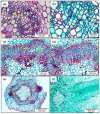Recent Advances in Adventitious Root Formation in Chestnut
- PMID: 33187282
- PMCID: PMC7698097
- DOI: 10.3390/plants9111543
Recent Advances in Adventitious Root Formation in Chestnut
Abstract
The genus Castanea includes several tree species that are relevant because of their geographical extension and their multipurpose character, that includes nut and timber production. However, commercial exploitation of the trees is hindered by several factors, particularly by their limited regeneration ability. Regardless of recent advances, there exists a serious limitation for the propagation of elite genotypes of chestnut due to decline of rooting ability as the tree ages. In the present review, we summarize the research developed in this genus during the last three decades concerning the formation of adventitious roots (ARs). Focusing on cuttings and in vitro microshoots, we gather the information available on several species, particularly C. sativa, C. dentata and the hybrid C.sativa × C. crenata, and analyze the influence of several factors on the achievements of the applied protocols, including genotype, auxin treatment, light regime and rooting media. We also pay attention to the acclimation phase, as well as compile the information available about biochemical and molecular related aspects. Furthermore, we considerate promising biotechnological approaches that might enable the improvement of the current protocols.
Keywords: Castanea; adventitious rooting; auxin; maturation; microshoots; trees.
Conflict of interest statement
The authors declare no conflict of interest.
Figures




References
-
- Vieitez F.J., Merkle S.A. Castanea spp. Chestnut. In: Litz R.E., editor. Biotechnology of Fruits and Nut Crops. CAB International; Wallingford, UK: 2005. pp. 265–296.
-
- Maynard C.A., Powell W.A., Polin-McGuigan L.D., Vieitez A.M., Ballester A., Corredoira E., Merkle S.A., Andrade G.M. Chestnut. In: Kole C., Hall T.C., editors. Compendium of Transgenic Crop Plants: Transgenic Forest Tree Species. Blackwell Publishing; Chichester, UK: 2014. pp. 169–192.
-
- Conedera M., Tinner W., Krebs P., de Rigo D., Caudullo G. Castanea Sativa in Europe: Distribution, Habitat, Usage and Threats. In: San-Miguel-Ayanz J., de Rigo D., Caudullo G., Durrant T.H., Mauri A., editors. European Atlas of Forest Tree Species. Publication Office of the European Union; Luxembourg: 2016. pp. 78–79.
-
- Nelson C.D., Powell W.A., Merkle S.A., Carlson J.E., Hebard F.V., Islam-Faridi N., Staton M.E., Georgi L. Biotechnology of Trees: Chestnut. In: Ramawat K., Merillon J.M., Ahuja M.R., editors. Tree Biotechnology. CRC Press; Boca Raton, FL, USA: 2014. pp. 3–25.
-
- Corredoira E., Martínez M.T., Cernadas M.J., San José M.C. Application of biotechnology in the conservation of the genus Castanea. Forests. 2017;8:394. doi: 10.3390/f8100394. - DOI
Publication types
Grants and funding
LinkOut - more resources
Full Text Sources

